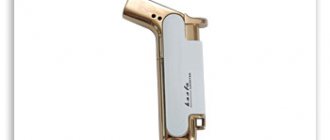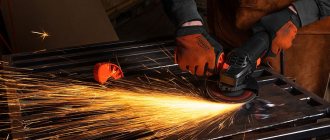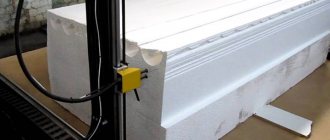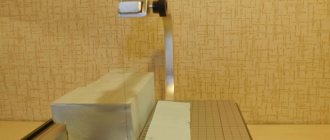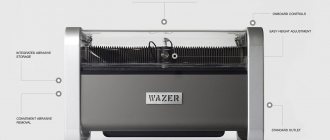Silicone Soldering Mat
Size 55 x 38 cm, weight 800 g....
More details
Nowadays, there is quite a lot of use of various measuring devices based on interaction with a personal computer. A significant advantage of their use is the ability to store the obtained values in a sufficiently large volume in the device’s memory, with their subsequent analysis.
Digital USB oscilloscope from a computer , which we describe in this article, is one of the options for similar measuring tools for amateur radio. It can be used as an oscilloscope and a device for recording electrical signals into the RAM and hard drive of a computer.
The circuit is not complicated and contains a minimum of components, resulting in a very compact device.
About virtual oscilloscopes.
I once had a fix idea: sell an analog oscilloscope and buy a digital USB oscilloscope to replace it. But, having wandered around the market, I discovered that the most budget oscilloscopes “start” at $250, and the reviews about them are not very good. More serious devices cost several times more.
So, I decided to limit myself to an analog oscilloscope, and to build some diagram for the site, use a virtual oscilloscope.
I downloaded several software oscilloscopes from the network and tried to measure something, but nothing good came of it, since either it was not possible to calibrate the device, or the interface was not suitable for screenshots.
I had already abandoned this matter, but when I was looking for a program to measure the frequency response, I came across the “AudioTester” software package. I didn’t like the analyzer from this kit, but the Osci oscilloscope (hereinafter I will call it “AudioTester”) turned out to be just right.
This device has an interface similar to a conventional analog oscilloscope, and the screen has a standard grid that allows you to measure amplitude and duration. https://oldoctober.com/
The disadvantages include some instability of work. The program sometimes freezes and in order to reset it you have to resort to the help of Task Manager. But all this is compensated by the familiar interface, ease of use and some very useful functions that I have not seen in any other program of this type.
Attention! The AudioTester software package includes a low frequency generator. I don't recommend using it because it tries to control the audio card driver itself, which can result in permanent audio muting. If you decide to use it, take care of a restore point or an OS backup. But, it’s better to download a normal generator from “Additional materials”.
Another interesting program for the Avangard virtual oscilloscope was written by our compatriot O.L. Zapisnykh.
This program does not have the usual measuring grid, and the screen is too large for taking screenshots, but it does have a built-in amplitude voltmeter and frequency meter, which partially compensates for the above disadvantage.
Partly because at low signal levels both the voltmeter and the frequency meter begin to lie a lot.
However, for a novice radio amateur who is not used to perceiving diagrams in Volts and milliseconds per division, this oscilloscope may be quite suitable. Another useful property of the Avangard oscilloscope is the ability to independently calibrate the two available scales of the built-in voltmeter.
So, I will talk about how to build a measuring oscilloscope based on the AudioTester and Avangard programs. Of course, in addition to these programs, you will also need any built-in or separate, most budget audio card.
Actually, all the work comes down to making a voltage divider (attenuator) that would cover a wide range of measured voltages. Another function of the proposed adapter is to protect the audio card input from damage when high voltage comes into contact with the input.
Return to top to menu.
Product customization
After assembling the USB oscilloscope, the last step is to the EEPROM flash 24LC64 memory chip For this:
- Download and install the Cypress Suite application on your computer.
- Launch the program and go to the EZ Console .
- Click on the inscription “ LG EEPROM ”.
- A window with the firmware file . Select it and run it with the Enter .
- If the error “ Error ” appears, start the firmware operation again.
- After the process has completed successfully, the message “ Done ” should appear. The oscilloscope is ready for use.
Before launching an oscilloscope based on an external audio adapter, do the following:
- Save the files miniscope.exe, miniscope.ini and miniscope.log from the downloaded archive in a separate folder. Open miniscope.exe .
- After starting the program, go to the settings and perform the actions shown in the pictures.
- To check functionality give a test signal. A sine wave should appear.
The device is ready for use.
Calibration is necessary for the device, which operates through an attenuator and an internal sound card. To do this, apply a signal with a known amplitude and frequency to the gadget. Having achieved a stable scan, turn on the measuring grid . By coordinating the actions of the trimming resistor with the adjustments on the control panel, bring the grid values to the original values.
If you cannot display the values correctly, you can adjust the grid using the audio controls on your computer. To do this, open the volume control located on the taskbar and, moving the slider, get the desired signal level.
Finished products must be grounded . Be careful when connecting a signal to the audio adapter port.
Technical data and scope.
Since there is an isolation capacitor in the input circuits of the audio card, the oscilloscope can only be used with a “closed input”. That is, only the variable component of the signal can be observed on its screen. However, with some skill, using the AudioTester oscilloscope you can also measure the level of the DC component. This can be useful, for example, when the multimeter reading time does not allow you to record the amplitude value of the voltage on a capacitor charging through a large resistor.
The lower limit of the measured voltage is limited by the noise level and background level and is approximately 1 mV. The upper limit is limited only by the parameters of the divider and can reach hundreds of volts.
The frequency range is limited by the capabilities of the audio card and for budget audio cards is: 0.1Hz... 20kHz (for a sine wave signal).
Of course, we are talking about a rather primitive device, but in the absence of a more advanced device, this one may well do.
The device can help in repairing audio equipment or be used for educational purposes, especially if it is supplemented with a virtual low-frequency generator. In addition, using a virtual oscilloscope it is easy to save a diagram to illustrate any material, or for posting on the Internet.
Return to top to menu.
Homemade set-top box with Bluetooth module
If a wider frequency range is required, then the above option will not work. This is where a new option comes to the rescue - a separate gadget, which is a set-top box with an analog-to-digital converter that provides signal transmission in digital form. In this case, the audio path of a smartphone or tablet is no longer used, which means that higher measurement accuracy can be achieved. In fact, at this stage they are only a portable display, and all information is collected by a separate device.
You can assemble an oscilloscope from an Android tablet with a wireless module yourself. There is an example on the network where a similar device back in 2010 was implemented using a two-channel analog-to-digital converter based on the PIC33FJ16GS504 microcontroller, and the LMX9838 Bluetooth module served as a signal transmitter. The device turned out to be quite functional, but difficult to assemble, so for beginners it will be an impossible task to make it. But, if desired, finding a similar project on the same amateur radio forums is not a problem.
Electrical diagram of the oscilloscope hardware.
The drawing shows the hardware part of the oscilloscope - “Adapter”.
To build a two-channel oscilloscope, you will have to duplicate this circuit. The second channel can be useful for comparing two signals or for connecting external synchronization. The latter is provided in AudioTester.
Resistors R1, R2, R3 and Rin. – voltage divider (attenuator).
The values of resistors R2 and R3 depend on the virtual oscilloscope used, or more precisely on the scales it uses. But, since the “AudioTester” has a division price that is a multiple of 1, 2 and 5, and the “Avangard” has a built-in voltmeter with only two scales interconnected by a ratio of 1:20, then using an adapter assembled according to the above the circuit should not cause inconvenience in both cases.
The input impedance of the attenuator is about 1 megohm. In a good way, this value should be constant, but the design of the divider would be seriously complicated.
Capacitors C1, C2 and C3 equalize the amplitude-frequency response of the adapter.
Zener diodes VD1 and VD2, together with resistors R1, protect the linear input of the audio card from damage in the event of accidental high voltage entering the adapter input when the switch is in the 1:1 position.
I agree that the presented scheme is not elegant. However, this circuit solution makes it possible in the simplest way to achieve a wide range of measured voltages using only a few radio components. An attenuator built according to the classical scheme would require the use of high-megaohm resistors, and its input impedance would change too significantly when switching ranges, which would limit the use of standard oscilloscope cables designed for an input impedance of 1 MOhm.
Return to top to menu.
Review of the best devices for radio amateurs
"Siglent SDS 1022"
A high-precision device that displays all signals. The upper limit of the signal frequency reaches 100 Hz. Works in 3 modes. The cost is about 16 thousand rubles. There is practically no error in operation. Processes signal frequencies from 10 to 100 Hz.
Trademark "Rigol"
Their main advantage is high performance, ease of use and adjustable sensitivity. A high-quality filter virtually eliminates errors. The device has a dual display.
The DS1102C model is widely used in work. Runs in frontal and inclined mode. The device is two-channel. The interface is simple. Price – 20 thousand rubles.
"Tektronics TDS 3064"
Despite the use of electronic lines for testing, thanks to it you can check the functioning of the board. Dual channel, wide bandwidth. Easily customizable digital filter. The advantage of the model is 20 automatic measurements. Thanks to the storage and playback function, it is possible to record data frame by frame. Built-in mathematical functions, auto-calibration, hardware frequency meter and Fourier converter. The device operates with a start delay. Compact model, nice design. Price – 22,000 rubles.
"Tektronics MSO 4104"
Like the previous model, it has a wide bandwidth of 100 MHz. At start, the sampling frequency is 1 Hz. The main feature of the model is the built-in input impedance. The device is two-channel, memory capacity is 1 MB.
High sensitivity vertically, can be triggered by video and front. Can perform all mathematical functions. The device allows you to obtain measurement data automatically. The model is quite compact and easily portable.
The price of the oscilloscope is about 18 thousand rubles.
Oscilloscopes from
Their main advantage is a user-friendly interface and versatility. Compared to previous devices, the bandwidth is not wide - about 60 MHz. Standard memory capacity (32,000 points). The device supports CP commands, screen resolution is 480 by 234 pixels. Six-digit hardware frequency counter.
USB oscilloscope review of the best models
The best in this category will be Hantek, Instrustar, SainSmart. These are the best budget options. Suitable for repairing TVs and laptops.
Based on these characteristics, choosing the right oscilloscope will be easy.
Protection from the "fool".
To protect the linear input of the audio card from accidental high voltage, zener diodes VD1 and VD2 are installed parallel to the input.
Resistor R1 limits the current of the zener diodes to 1 mA, at a voltage of 1000 Volts at the 1:1 input.
If you really intend to use an oscilloscope to measure voltages up to 1000 Volts, then as resistor R1 you can install MLT-2 (two-watt) or two MLT-1 (one-watt) resistors in series, since the resistors differ not only in power, but also according to the maximum permissible voltage.
Capacitor C1 must also have a maximum allowable voltage of 1000 Volts.
A little clarification of the above. Sometimes you want to look at a variable component of relatively small amplitude, which nevertheless has a large constant component. In such cases, you need to keep in mind that on the screen of an oscilloscope with a closed input, you can only see the alternating voltage component.
The picture shows that with a constant component of 1000 Volts and a swing of the variable component of 500 Volts, the maximum voltage applied to the input will be 1500 Volts. Although, on the oscilloscope screen we will only see a sine wave with an amplitude of 500 Volts.
Return to top to menu.
Single channel model
Oscilloscope s1 73
Such a device has one input - one beam. The structural structure is shown in Fig. higher. The scheme includes:
- screen – CRT;
- Y-scan block: attenuator, pre-amplifier, delay circuit, initial sync gain and final output amplifier;
- X-scan unit: synchronization device, scan unit, output amplifier;
- backlight amplification circuit;
- calibrator;
- network power supply.
In such a device, the monitoring signal is supplied to one input and is displayed by the movement of the beam on the screen. This is enough to measure a number of parameters.
How to measure the output impedance of a line output?
You can skip this paragraph. It is designed for lovers of small details.
The output impedance (output impedance) of a line output designed to connect phones (headphones) is too low to have a significant impact on the accuracy of the measurements we will perform in the next paragraph.
So why measure output impedance?
Since we will use a virtual low-frequency signal generator to calibrate the oscilloscope, its output impedance will be equal to the output impedance of the Line Out of the sound card.
By making sure that the output impedance is low, we can prevent gross errors when measuring the input impedance. Although, even under the worst circumstances, this error is unlikely to exceed 3... 5%. Frankly, this is even less than the possible measurement error. But it is known that errors have a habit of “running up”.
When using a generator to repair and tune audio equipment, it is also advisable to know its internal resistance. This can be useful, for example, when measuring ESR (Equivalent Series Resistance) or simply the reactance of capacitors.
Thanks to this measurement, I was able to identify the lowest impedance output in my audio card.
If the audio card has only one output jack, then everything is clear. It is both a line output and an output for phones (headphones). Its impedance is usually small and does not need to be measured. These are the audio outputs used in laptops.
When there are as many as six sockets and there are a couple more on the front panel of the system unit, and each socket can be assigned a specific function, then the output impedance of the sockets can differ significantly.
Typically, the lowest impedance corresponds to the light green jack, which by default is the line output.
| Color/location | Switch state | |
| Phones (Ohm) | Line Out (Ohm) | |
| Lime / Rear | 5 | 230 |
| Grey/Rear | 7 | 230 |
| Lime/Front | 12 | 80 |
| Laptop | 0,7 | Doesn't switch |
An example of measuring the impedance of several different audio card outputs set to “Telephones” and “Line Out” modes.
As can be seen from the formula, the absolute values of the measured voltage do not play a role, therefore these measurements can be made long before calibrating the oscilloscope.
Calculation example.
R1 = 30 Ohm.
U1 = 6 divisions.
U2 = 7 divisions.
Rx = 30(7 – 6) / 6 = 5 (Ohm).
Return to top to menu.
Using PPR1 series resistors
Devices containing elements of this line are very popular. Due to their high sensitivity, they are used for monitoring electrical equipment. To create this meter you will need a CRT, a pulse modulator, a rectifier and contactors with plates. The installation of a kenotron is justified by the accuracy of the readings obtained. The operational type device requires the installation of a controller.
The resistance value is not higher than 34 Ohms, and the signal conductivity is 4.2-4.5 Ohms. A USB port is connected through a low conductivity modulator. Spectral expanders for the circuit are taken of the pulse type.
Important! It is necessary to organize voltage stabilization, fix the expander next to the comparator, which will reduce heat losses.
How to measure the input impedance of a linear input?
To calculate the attenuator for the linear input of an audio card, you need to know the input impedance of the linear input. Unfortunately, it is impossible to measure the input resistance using a conventional multimeter. This is due to the fact that there are isolation capacitors in the input circuits of audio cards.
The input impedances of different audio cards can vary greatly. So, this measurement will still have to be done.
To measure the input impedance of an audio card using alternating current, you need to apply a sinusoidal signal with a frequency of 50 Hz to the input through a ballast (additional) resistor and calculate the resistance using the given formula.
A sinusoidal signal can be generated in a software low-frequency generator, a link to which is in the “Additional Materials”. Amplitude values can also be measured using a software oscilloscope.
The picture shows the connection diagram.
The voltages U1 and U2 must be measured with a virtual oscilloscope in the corresponding positions of the SA switch. There is no need to know the absolute voltage values, so the calculations are valid until the device is calibrated.
Calculation example.
R1 = 50kOhm.
U1 = 100
U2 = 540
Rx = 50 * 100 / (540 – 100) ≈ 11.4 (kOhm).
| Color/Location | Impedance (kOhm) |
| Red/Rear | 82 |
| Black/Rear | 75 |
| Lime/Front | 11,4 |
| Pink/Front | 50 |
| Laptop | 8,5 |
Here are the results of impedance measurements of various line inputs.
As you can see, the input resistances differ significantly, and in one case, almost an order of magnitude.
Return to top to menu.
How to calculate a voltage divider (attenuator)?
The maximum unlimited amplitude of the audio card input voltage, at the maximum recording level, is about 250 mV. A voltage divider, or as it is also called an attenuator, allows you to expand the range of measured voltages of an oscilloscope.
The attenuator can be constructed using different circuits, depending on the division coefficient and the required input resistance.
Here is one of the divider options that allows you to make the input resistance a multiple of ten. Thanks to the additional resistor Rext. you can adjust the resistance of the lower arm of the divider to some round value, for example, 100 kOhm. The disadvantage of this circuit is that the sensitivity of the oscilloscope will depend too much on the input impedance of the audio card.
So, if the input impedance is 10 kOhm, then the division ratio of the divider will increase tenfold. It is not advisable to reduce the resistor of the upper arm of the divider, since it determines the input resistance of the device, and is the main element in protecting the device from high voltage.
So, I suggest you calculate the divider yourself based on the input impedance of your audio card.
There is no error in the picture; the divider begins to divide the input voltage already when the scale is 1:1. Calculations, of course, need to be done based on the actual ratio of the divider arms.
In my opinion, this is the simplest and at the same time the most universal divider circuit.
Using the presented formulas, you can calculate the attenuator for the adapter if you agree with the proposed circuit.
An example of divisor calculation.
Initial values.
R1 – 1007 kOhm (result of measuring a 1 mOhm resistor).
Rin. – 50 kOhm (I chose the higher-impedance input of the two available on the front panel of the system unit).
Calculation of the divider in the switch position 1:20.
First, using formula (1), we calculate the division coefficient of the divider, determined by resistors R1 and Rin.
(1007 + 50)/ 50 = 21,14 (once)
This means that the total division ratio in the switch position 1:20 should be:
21,14*20 = 422,8 (once)
We calculate the resistor value for the divider.
1007*50 /(50*422,8 –50 –1007) ≈ 2,507 (kOhm)
Calculation of the divider in the switch position 1:100.
We determine the overall division ratio at the switch position of 1:100.
21,14*100 = 2114 (once)
We calculate the resistor value for the divider.
1007*50 / (50*2114 –50 –1007) ≈ 0,481 (kOhm)
To make calculations easier, take a look at this link: How to pair Notepad with the Windows Calculator to make calculations easier?
If you are going to use only the Avangard oscilloscope and only in the 1:1 and 1:20 ranges, then the accuracy of resistor selection may be low, since the Avangard can be calibrated independently in each of the two available ranges. In all other cases, you will have to select resistors with maximum accuracy. How to do this is written in the next paragraph.
If you doubt the accuracy of your tester, then you can adjust any resistor with maximum accuracy by comparing ohmmeter readings.
To do this, instead of a permanent resistor R2, a tuning resistor R* is temporarily installed. The resistance of the trimming resistor is selected so as to obtain the minimum error in the corresponding division range.
Then the resistance of the trimming resistor is measured, and the constant resistor is already adjusted to the resistance measured by an ohmmeter. Since both resistors are measured with the same device, the ohmmeter error does not affect the measurement accuracy.
And these are a couple of formulas for calculating the classic divisor. A classic divider can be useful when a high input impedance of the device (mOhm/V) is required, but you don’t want to use an additional dividing head.
Return to top to menu.
Best Oscilloscope Software for Windows PC
PC
Oscilloscope programs are software for your computer that can analyze audio signals. If you are on a tight budget and cannot afford a full-fledged oscilloscope, then this PC software will come in handy. The following programs were tested using audio input through my computer's 3.5mm audio input.
Now let's see what this software has to offer. Once these programs start reading the input signal, you can view the signal spectra for both or one of the two channels. Most of these programs also provide the ability to view the FFT spectrum. While some of these programs are just audio spectrum analysis software, some provide detailed signal data. You can measure frequency, peak voltage, crest factor, phase, etc. One of these free oscilloscope programs provides a Filter option, where you can apply a finite impulse response filter to the signal input and then analyze the signal.
As you go through the list, you will learn about the features they offer.
Best Oscilloscope Software for Windows PC
Winscope
Winscope is free oscilloscope software that can be used to analyze any signal on your computer. When you input a signal, it allows you to view its spectrum, measure frequency, plot graphs, view FFT spectrum, save signal data, and more. It reads the input signal through your computer's 3.5mm audio jack.
How to select or adjust voltage divider resistors?
Since radio amateurs often have difficulty finding precision resistors, I will talk about how you can adjust common resistors for a wide range of applications with high accuracy.
High-precision resistors are only several times more expensive than conventional ones, but on our radio market they are sold for 100 pieces, which makes their purchase not very advisable.
Using trim resistors.
As you can see, each arm of the divider consists of two resistors - a constant one and a trimmer one.
Disadvantage: cumbersome. Accuracy is limited only by the available accuracy of the measuring instrument.
Selection of resistors.
Another way is to select pairs of resistors. Accuracy is ensured by selecting pairs of resistors from two sets of resistors with a large spread. First, all resistors are measured, and then pairs are selected whose sum of resistances most closely matches the circuit.
It was in this way, on an industrial scale, that the divider resistors for the legendary TL-4 tester were adjusted.
The disadvantage of this method is that it is labor intensive and requires a large number of resistors.
The longer the list of resistors, the higher the selection accuracy.
Adjusting resistors using sandpaper.
Even industry does not shy away from adjusting resistors by removing part of the resistive film.
However, when adjusting high-resistance resistors, it is not allowed to cut through the resistive film. For high-resistance film resistors MLT, the film is applied to a cylindrical surface in the form of a spiral. Such resistors must be filed extremely carefully so as not to break the circuit.
Precise adjustment of resistors in amateur conditions can be done using the finest sandpaper - “null sandpaper”.
First, the protective layer of paint is carefully removed from the MLT resistor, which obviously has a lower resistance, using a scalpel.
The resistor is then soldered to the “ends”, which are connected to the multimeter. By careful movements of the “zero” skin, the resistance of the resistor is brought to normal. When the resistor is adjusted, the cut area is covered with a layer of protective varnish or glue.
What a “zero” skin is is written here.
In my opinion, this is the fastest and easiest way, which, nevertheless, gives very good results.
Return to top to menu.
Construction and details.
The elements of the adapter circuit are housed in a rectangular duralumin housing.
The attenuator division ratio is switched using a toggle switch with the middle position.
The standard CP-50 connector is used as the input jack, which allows the use of standard cables and probes. Instead, you can use a regular 3.5mm Jack audio jack.
Output connector: standard 3.5mm audio jack. The adapter connects to the linear input of the audio card using a cable with two 3.5mm jacks at the ends.
The assembly was carried out using the hinged mounting method.
To use the oscilloscope you will need another cable with a probe at the end.
How to make it is written in detail here.
Return to top to menu.
How to calibrate a virtual oscilloscope?
To calibrate an oscilloscope, you need to have at least some kind of measuring instrument. Any pointer tester or digital multimeter that you trust will do.
Due to the fact that some testers have too high an error when measuring alternating voltage up to 1 Volt, we perform calibration at the maximum possible voltage, but unlimited in amplitude.
Before calibration, we make the following settings.
Disable the audio card equalizer.
“Line output level”, “WAVE level”, “Line input level” and “Recording level” are set to the maximum gain position. This will ensure repeatability of the result during further measurements.
Having reset the generator settings just in case using Command > Get Generator Default Setting, set the “Gain” (level) to 0db.
We select the generator frequency of 50Hz using the “Frequency Presets” switch, since all amateur instruments for measuring alternating voltage can operate at this frequency, and our adapter cannot yet operate correctly at higher frequencies.
Switch the adapter input to 1:1 mode.
Looking at the oscilloscope screen, use the Trim generator knob to select the maximum unlimited signal level.
The signal may be limited both at the input of the audio card and at its output, and the accuracy of calibration may be significantly reduced. AudioTester even has a special overload indicator, which is highlighted in red in the screenshot.
Using a tester, we measure the voltage at the generator output and calculate the corresponding amplitude value.
Example.
Voltmeter reading = 1.43 Volts (rms).
We get the amplitude value.
1,432*√2 = 2,025 (Volt)
The “Options > Calibrate” command brings up the “AudioTester” calibration window.
And although the dimension in “mVrms” is indicated next to the input window, which in theory should mean the root mean square value, in reality, in the “oszi v2.0c” oscilloscope from the “AudioTester” kit, the entered values correspond to... it’s not clear what. Which, however, does not at all prevent you from accurately calibrating the device.
By entering values in small increments, you can precisely adjust the size of the sine wave image to the amplitude value calculated above.
The picture shows that the signal amplitude is a little more than two divisions, which corresponds to 2.02 Volts.
The accuracy of the display of the amplitude of the signals received from the 1:20 and 1:100 inputs will depend on the accuracy of the selection of the corresponding divider resistors.
When calibrating the Avangard oscilloscope, the values obtained during measurement by the tester must also be multiplied by √2, since both the voltmeter and the Avangard calibrator are designed for amplitude values.
Enter the resulting value into the calibration window in millivolts - 2025 and press Enter.
To calibrate the second range of the Avangard oscilloscope, which is about, you must first calculate the real division factor by comparing the readings of the built-in voltmeter in two divider ranges: 1:1 and 1:20. The oscilloscope voltmeter should be in the “12.5” position
Example.
122 / 2323 = 19,3
Then you need to correct the “calibr” file, which can be opened in Notepad. On the left is the file before editing, and on the right is after.
The "calibr" file is located in the same directory as the current copy of the program.
In the eighth line we enter the real division coefficient corresponding to the divider of the first (left) channel.
If you have built a two-channel adapter, then in the ninth line we make an amendment for the second (right) channel.
Return to top to menu.
EDUCATIONAL GOALS FOR DCACLAB
The DCACLab is implemented for the purposes of developing and reinforcing knowledge and skills necessary for supporting mastery of objectives of the lesson. It allows the learner to apply scientific methods, respond to questions, gather the necessary materials, follow procedures, use tools and equipment, as well as draw conclusions. The virtual lab experience involves hands-on activities plus virtual experiences in a lab-like setting. This lab, therefore, provides learners with virtual experiences that engage them in a realistic manner as they maintain the integrity of similar hands-on lab activities. , the educational goals for DCACLab can be summarized in point form as follows in terms of what the learner should Thus be able to do at the end of the lab:
- Explain the basic electricity relationships.
- Create circuits out of schematic drawings.
- Make use of a voltmeter and ammeter to take circuit readings.
- Provide a logical explanation of the measurements as well as the circuit relationships.
- Explain basic electricity relationships both in parallel and series circuits.
- Develop a theory for explaining the circuit measurements.
- Find the resistance of different objects using the virtual lab.
- Discuss the charging and discharging processes of a capacitor in a circuit.
- Explain how an inductor behaves in a circuit.
ANALOG MULTIMETERStudents can experiment with this multimeter that measures Selection Knob can be used to easily set the required meter and choose from several ranges of value. Meters to choose from are:
AC Voltmeter
DC Voltmeter
Amperemeter
Ohmmeter
OSCILLOSCOPE VOLTAGE MEASUREMENT
Oscilloscope, measure time delta between two peaks
This handy oscilloscope can measure voltage by using realistic leads!
Oscilloscope measure phase shift
The oscilloscope can measure current also.
OSCILLOSCOPE TIME/DIV, VOLT/DIV SETTING
Multiple functions for each oscilloscope channel.
Students can easily observe the different settings of time base or volts/div that is found in the real oscilloscope, and can chose from multiple functions for each channel.
The oscilloscope has multiple functionalities, it can show voltage, ampere and root mean square (RMS). RMS voltage is the most common way to calculate the voltage of an AC circuit. DCAClab calculates RMS by sampling the input voltage and doing the sum-of-the-squares, simulating the high quality voltmeters, both AC meter and oscilloscope has RMS, the oscilloscope plots a dashed line to indicate the RMS.
Experiment with multiple wattmeters simultaneously.
ABCD RESISTOR COLOR BANDS
Set resistance using color bands Tolerance is randomly generated according to the selected color of band D Students can change colors of resistor and see the simulation in real time.
RESISTANCE DIRECT VALUE
Users can set resistance by writing the value and setting value unit (nano, micro, milli, kilo, mega, giga) Tune slider allows setting modifying value using (nano, micro, milli)
CIRCUIT ANALYSIS USING KIRCHHOFF CURRENT LAW
Current Animation
Easy dynamic circuit analysis for Kirchhoff’s current law
for schools sales
We are selling DCACLab through FastSpring, our payment processor. FastSpring (which is a US company) will be the vendor in the transaction and their company information will be on your invoice.
W-9 form can be downloaded here: https://www.fastspring.com/w9.pdf
How to equalize the amplitude-frequency response of the adapter?
The linear input of the audio card, and the adapter circuits themselves, have some input capacitance. The reactance of this capacitance changes the division ratio of the divider at high frequencies.
To equalize the frequency response of the adapter in the 1:1 range, you need to select the capacitance of capacitor C1 so that the amplitude of the signal at a frequency of 50 Hz is equal to the amplitude of the signal with a frequency of 18-20 kHz.
Resistors R2 and R3 reduce the influence of the input capacitance and create an increase in the frequency response in the high frequency region. This rise can be compensated by selecting capacitors C2 and C3 in the corresponding ranges of 1:20 and 1:100.
I selected the following capacitances: C1 – 39pF, C2 – 10nF, C3 – 0.1nF.
Now that the Y channel of the oscilloscope's vertical deviation is calibrated and linearized, you can see what certain periodic signals, and more, look like. “AudioTester-e” has “waiting scan synchronization”.
Return to top to menu.
Dual Channel Devices
When it is necessary to compare two types of signals, such devices are used. There are two varieties:
- Two-channel – for observing pulses from identical Y-channels. By switching the toggle switch, output signals are alternately supplied to the CRT plates. Observe each signal of inputs Y1-Y2 separately or together. The second - at each reverse sweep.
- Double-beam - they have two separate Y-channels and a two-beam CRT design. Such a device has a joint start of the horizontal scan generator, the inclusion of vertical scan occurs for each channel separately. This allows you to see 2 waveforms simultaneously.
